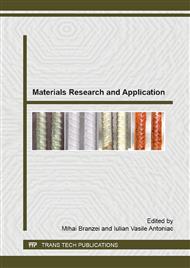p.38
p.44
p.50
p.56
p.62
p.68
p.76
p.81
p.86
Microstructural Investigation of Aluminum Alloys Type "2024" for the Aviation Industry
Abstract:
This paper presents experimental results revealed on the samples type 2024 aluminum alloy used in aeronautics. The results of microstructural and compositional investigations presented in this paper were performed on samples taken from 2024 Al alloy samples produced by ALRO Slatina. The main objective of the investigation is the conformity assessment of alloys in terms of chemical composition with the specifications type of aviation [SAE AMS 47N, EN 515, etc]. It also aims microstructural conformity assessment in terms of the grain and the hardening effects by natural or artificial aging applied by the manufacturer. Adequate characterization of 2024 aluminum alloys type was achieved by combined investigations: (i) Wet Chemical Analysis, (ii) Spectrochemical Analysis and (iii) Electron Microscopy. The main conclusion that emerges from the investigations carried out on aluminum samples revealed that: (a) alloys fits in terms of composition with the standard specification for 2024, in all cases; (b) microstructure vary in fineness of grain, but meets the requirements of aviation rules; the investigated microstructures have been appreciated as adequate of aluminum alloys type "2024".
Info:
Periodical:
Pages:
62-67
Citation:
Online since:
July 2015
Price:
Сopyright:
© 2015 Trans Tech Publications Ltd. All Rights Reserved
Share:
Citation:


